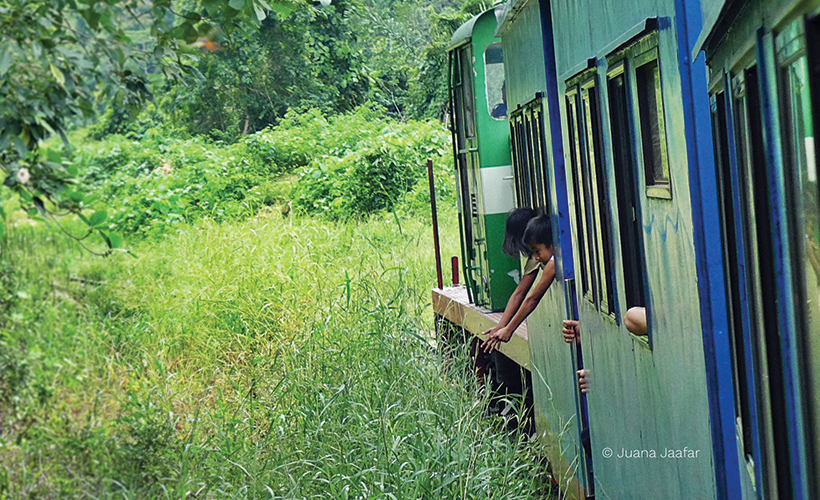
When I was a teen my father told me about a steam engine train in Sabah he wanted to journey on someday. Sadly he didn’t live long enough for it but his adventure stuck with me. I remember making inquiries about it over the years but those I spoke to said the service was terminated.
Just as well, I thought, as it was expensive to even get to Sabah in those pre-budget airline days. It was also a time before the Internet became my go-to place for the latest information, if at all such information was available online then.
But I did make a mental note: One day, go look up that train and get on it.
That “one day” came recently, kind of. I was in Sabah on a work assignment and decided that would be the trip I’d hunt for the train. Thanks to present day Internet I found out the train is indeed back in service but is also privately run, and tickets are sold at MYR345 (USD79) a pop.
It runs from Kota Kinabalu to Papar and packaged as a half-day programme with short stops in Kinarut and Papar for touristy sightseeing. How badly did I want to get on that train? Pretty badly. It’s a heritage train and I have legit nostalgic reasons to be on it.
Did I have money to blow? No. I also wasn’t interested in a tourist package.
This train service—the ‘North Borneo Railway’—kept coming up on my search results but a check on the Sabah railway map shows it barely runs the entire line. What about the rest of the way? Were there other trains? Apparently so, but therein lies the huge information gap.
Another site that kept popping up on my search was the official website of the Jabatan Keretapi Negeri Sabah (Sabah State Railway Department). Unfortunately, it doesn’t provide any useful information for passengers.
No schedules, no information on ticket prices, no online purchasing services. To add, my calls to all the phone numbers provided were left unanswered. At one point I thought perhaps the Department didn’t actually exist and its website was just a parody.
Then again a few blogs published some years ago testify to the existence of the Department as well as a state operated service that ran from Kota Kinabalu all the way to Tenom. That said, they also warned about irregularities and surprise cancellations.
Since I didn’t have the luxury of time nor the mood for surprises I took to Twitter and directly contacted Masidi Manjun, the state’s Minister of Tourism, Culture and Environment. Now here’s a committed public official. He promptly provided me with contact details of the Department’s General Manager. And a kind staff, Nitta, also got in touch with me. With their assistance I managed to get the information I needed.
“I’m sure the trains in Kuala Lumpur aren’t like this,” he said referring to the condition of the no-frills, rusted carriages. “They don’t even come close,” I replied. “Just look at that,” I said, gesturing toward the grand Banjaran Crocker outside.
As it turns out the Department’s main office in Kota Kinabalu is in the midst of moving from the old Tanjung Aru station to a sparkly new office and station right behind it. It’s so new that taxi drivers are still unaware of the move.
And you do need to take a taxi if you don’t have friends on the ground to give you a lift. The station is about 6 kilometres from town centre and 4 kilometres from the Kota Kinabalu International Airport.
Anyway, I was glad to be given phone numbers of people to call because an impromptu visit to the station for advance ticket purchase turned out to be futile. The ticket counter closed at 11:30AM on that day and would only reopen at 5:00PM. Strange indeed.
The officer I called assured me the counter will open on the morning of my departure. But whether I’ll be able to make it all the way to Tenom, he could only say they’ve not had any cancellations in the past one month.
My hope is that the Department’s new office will see to better services and a complete revamp of their website. Truly, the Sabah railway experience deserves it. I may not have made it onto the classic steam engine train but I did make it all the way to the end of the line. And that 134-kilometre excursion, while it may be short compared to other rail journeys, was absolutely spellbinding.
I got on the first train out of the new station in Kota Kinabalu that departed sharp at 7:45AM for Beaufort. There’s no direct service from Kota Kinabalu to Tenom so you have to break your journey in Beaufort and purchase a separate ticket there.
Beaufort is also the station where you find out if the Tenom service is operating on that day. And if you do intend to head to Tenom on the same day you need to get on that 7:45AM train from Kota Kinabalu in order to catch the connecting train in Beaufort at 1:30PM.
So off I went to Beaufort to take a chance on Tenom. In a worst-case scenario I’d stay the night in Beaufort or make it a day trip and return to Kota Kinabalu. The journey takes about two hours on a commuter train, and at MYR4.80 (USD1) it was a chance I could afford.
The air-conditioned train makes a comfortable journey. The carriages looked reasonably new and well maintained, although the seats could do with some serious vacuuming. There were quite a number of passengers but the train wasn’t packed.
Honestly, it was a pretty sedate cruise compensated by breathtaking views of the South China Sea on some stretches. The train also passed by quaint villages before arriving in Beaufort at about 9:40AM.
I had some time to kill. Inspired to write, I parked myself at a little dim sum joint across the street from the station. The dim sum was mediocre but the restaurant had power outlets, WiFi and a clean toilet. I declared victory as I minded my own business and chomped on warm food.
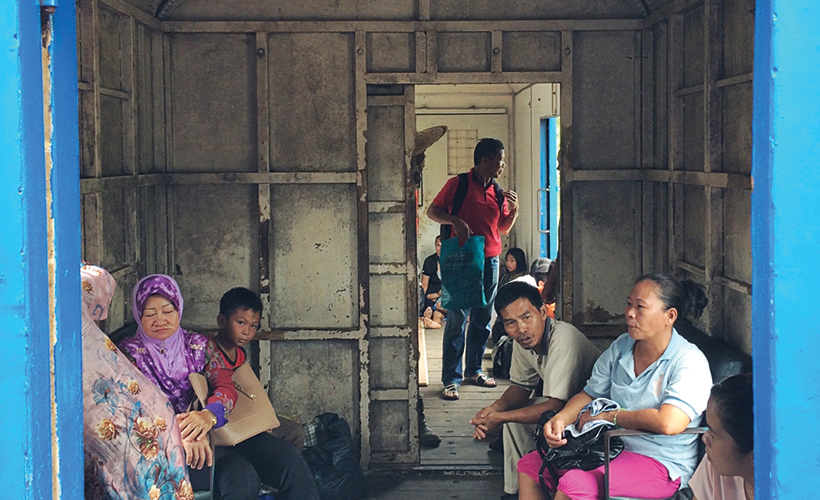
About fifteen minutes before the scheduled departure I went back to the station to check if the Tenom service was on. To my delight the train was already there, waiting. A gigantic smile came upon me when I saw it. It was the real deal, and I didn’t quite expect it.
I paid MYR2.80 (USD0.60) for a one-way ticket to Tenom and very likely skipped all the way into the carriage.
Unlike the previous train this one was a series of aged carriages with its windows wide open (no air-conditioning). Some carriages had isle seats that reminded me of buses from the 1980s. Well, you know, with barely any cushioning and a stiff back.
And then there were the cargo cars with only a few seats against the sides and large openings for bulky goods to enter. Some people brought gas tanks, some had large boxes and supplies for the villages.
But the best cargo were the children. They were a joy to be around. And you could tell right away they were one with the train. They knew their way around and had their own favourite spots. And the adults too, as some settled on the floor in the cargo car.
Adios, protocol! Toodle-dooo! See ya, wouldn’t wanna be ya!
On the dot at 1:30PM the station master blew his whistle and the train took its first thrust with an abrasive jolt. “Wooohooo!” my heart screamed as the conductor blew the horn. I was on my way to the hills!
Do you salsa? Well, you most certainly will on this ride. It’s a bumpy trip the whole way and whether sitting or standing you’ll find your hips doing all sorts of funky moves to the loud sounds of solid steel grooving against each other. Best to take it all in and enjoy.
Somewhere along the way the conductor struck a conversation with me. “I’m sure the trains in Kuala Lumpur aren’t like this,” he said referring to the condition of the no-frills, rusted carriages. I looked around. The train may be worn out but it was squeaky clean.
“They don’t even come close,” I replied. “Just look at that,” I said, gesturing toward the grand Banjaran Crocker outside. We may have fancier trains in Kuala Lumpur but we’re surrounded by soulless cement and steel. The conductor didn’t disagree.
I didn’t realise how much I needed the trip until I was sitting there by the carriage door with wind blowing in my face, just taking in the wisdom and beauty of the 140 million-year-old rainforest surrounding me. What a privilege.
I’d come looking for my father’s steam engine train adventure but what I got was even better. I got the whole line, the deep forest and the mountain range. And stories, on a rickety train too. I got my own adventure, and one that cost much less. He would’ve been pleased.
What’s more, the railroad runs parallel to Sungai Padas from Beaufort to Tenom, so for much of the journey I had a view of the river that got more and more riveting the deeper we wandered into the hills. Here’s a tip: The river runs to your right on the journey up to Tenom, and to your left on the way down.
The train made various stops along the way including picking children up from school and dropping them off at unofficial stops as we passed through villages, or lone little platforms in the middle of the woods, much like isolated bus stops.
In fact the journey’s atmosphere was that of a school bus, boisterous and cheery. Children played and waved their friends off at each stop. Some preferred to just enjoy the view, one that continues to mesmerise them every day.
I’d moved from the second carriage to the last quite early in the trip to escape the diesel fumes. At the back I had the company of school children having loads of fun. It got too rowdy at one point causing a stern voice of an old woman to rise from the front car.
“Ya, Nenek (Yes, Granny)…” the children replied defeatedly and behaved themselves. As it turned out Nenek was chaperoning about seven or eight children back from school to the village. It was really nice seeing community in action and children having an elder watch over them.
We stopped at the Halogilat station in the hills to transfer onto another train that would take us to Tenom. No new ticket needed at this stop, just a hop-off-hop-on. I saw Nenek from afar as I boarded the next train while she and the children made their way out of the station.
She looked like she could be in her late-70s, thin and frayed. I saw her struggling with a 10-litre container of water and it made me feel sad. And soon enough that feeling turned into anger. I was so angry my eyes teared.
Only days before the Malaysian Anti-Corruption Agency (MACC) arrested officials from the Sabah State Water Department suspected of syphoning more than MYR100 million of public funds; funds that should’ve gone into supplying water to Nenek’s village and others in the countryside.
There were a number of foreign tourists at the station waiting for their ride back to Beaufort. Apparently the route is popular among tourists keen on white water rafting. They disembark at the Pangi station just before Tenom to start their adventure down Sungai Padas.
Anyway, we took off from Halogilat within minutes and onto the most exciting part of the journey. The forest closes in so watch out for stray tree branches if you’re by the door. One greeted me smack on the forehead. Nothing serious, the woods just wanted me to know everything around me was real.
An older woman sitting nearby asked what special event awaited me in Tenom. “This is the special event,” I replied. She smiled. “Not afraid to travel alone?” she probed further. No. “Tak sunyi (Not lonely)?” she asked. I smiled.
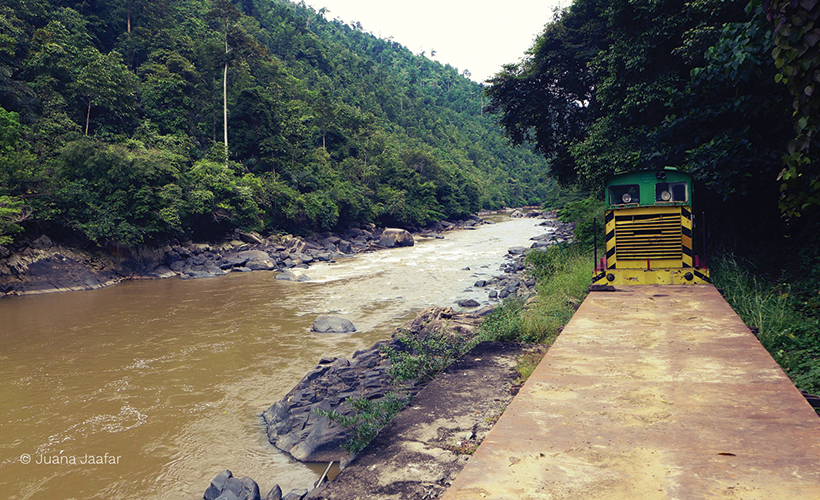
A man joined in our conversation to ask if either of us watched the Akademi Fantasia finale, a local music reality show. No. He then proceeded to tell me about the teachers onboard the train. They were mainly from Semenanjung Malaysia. Maybe he thought I might know one of them, at least.
I looked at those who could pass off as public school teachers and they all looked miserably tired. One by one he pointed to me who was from Terengganu, Pahang, Johor… He knew everyone. The woman listened and nodded, and corrected him when he mixed up the profiles.
Outside I noticed Sungai Padas had become really shallow, exposing huge rocks on the riverbed and on the banks. The man pointed at the Tenom Pangi Dam ahead. Water had been re-routed further down the river.
“It’s haunted,” he said, noting the power station. “Considering everything it drowned I’d be surprised if it weren’t,” I replied. The man, and the woman, nodded. And then I couldn’t resist myself: “So, do all the villages up here have electricity?”
The woman and man let out a small, cynical laugh. “Remember the school we passed back there? They only got electricity about five years ago. Many others up here are still off the grid,” the man told me. The dam was built in 1978 and completed in 1984.
Perhaps the woman didn’t trust my mathematics, so she added, “That’s 30 over years since this thing was built”. I could only afford to acknowledge them with a nod. We chugged by the power station in awkward silence until the train crawled slower uphill.
Excitedly the man asked, “Haaa! Guess what’s our speed right now?” I looked outside and imagined myself driving. I offered an informed guess: “15 kilometres per hour?” “Very good!” he said, “Yes, this is the slowest part because we’re climbing a steep hill. Tenom is right after this climb”.
I arrived at the Tenom station both exhausted and exhilarated. I sat at the platform for a little while just to digest the day’s journey. I’d come looking for my father’s steam engine train adventure but what I got was even better. I got the whole line, the deep forest and the mountain range. And stories, on a rickety train too.
I got my own adventure, and one that cost much less. He would’ve been pleased.
I walked through a night market for some food and checked into a hotel up the hill where I watched the sunset, ate my night market dinner, slept, watched terrible television, did some writing, slept again and woke up to see the sun rise over Banjaran Crocker.
It was perfect. And I still had the journey back to look forward to.
Cheat sheet:
[my_wp_accordian count=”4″ title=”Kota Kinabalu – Beaufort||Beaufort – Tenom||Tenom – Beaufort||Beaufort – Kota Kinabalu” description=”ETD: 7:45AM ETA: 9:40AM Price per ticket: MYR4.80||ETD: 1:30PM (Transfer to Halogilat) ETA: 3:55PM Price per ticket: MYR:2.80||ETD: 7:00AM (Transfer to Halogilat) ETA: 9:50AM Price per ticket: MYR2.80||ETD: 11:00AM ETA: 1:30PM Price per ticket: MYR4.80″]
The above schedule is recommended for the same day travel from Kota Kinabalu to Tenom, or from Tenom to Kota Kinabalu from Monday to Saturday
This story was originally published on www.juanajaafar.net
Zafigo republished this story in full with permission from the author to hopefully bring the story and the author to a larger audience, simply because good authors and stories should be read by as many people as possible! If you are keen on Zafigo republishing your stories that will be of interest and useful to women travellers especially in Asia, please get in touch with us at [email protected].
![]()
Read Next:
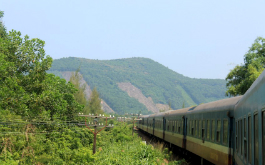 |
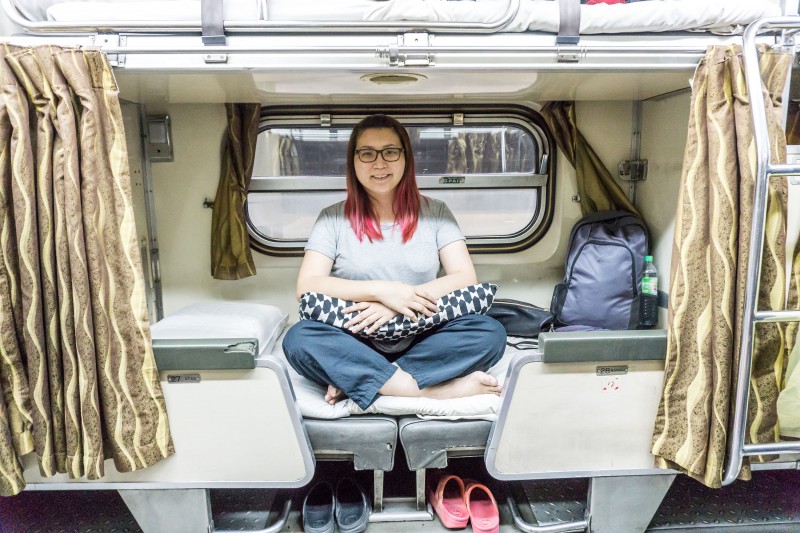 |
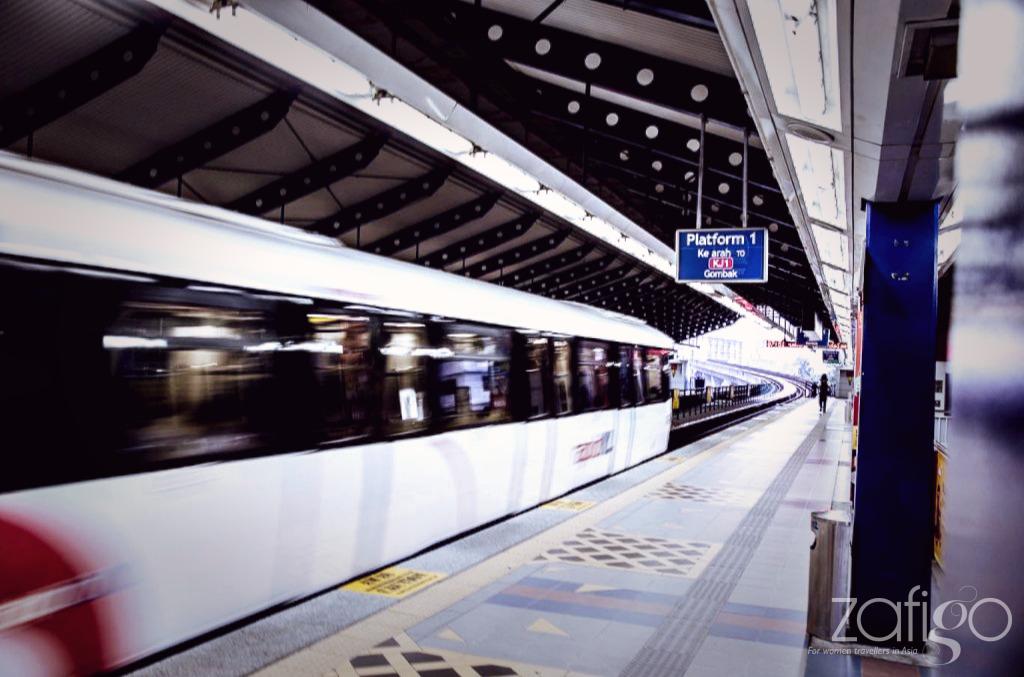 |
| Finding Peace Of Mind On Long Train Journeys | KL To Singapore: An Overnight Train Adventure | My Kuala Lumpur: Of Buses, Trains & Roads Taken |